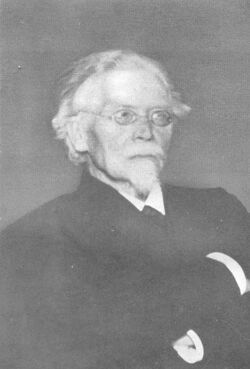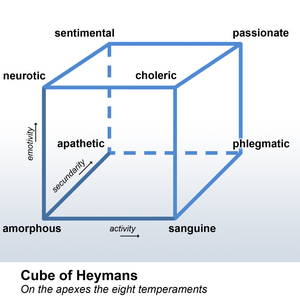Biography:Gerardus Heymans
Gerardus Heymans (17 April 1857, Ferwert – 18 February 1930, Groningen) was a Dutch philosopher, psychologist, a follower of Gustav Fechner's idea of psychic monism, and from 1890 to 1927 a professor at Groningen University.[1] His thought was influenced by the work of the Russian philosopher Afrikan Spir.[2][note 1]
Academic career
Heymans studied law and philosophy in Leiden University under Jan Pieter Land, Simon Vissering and Joannes Buys. He passed his exams in public law on 23 October 1879 and on 29 June 1880 he was awarded a PhD on a dissertation in Political Economics "Karakter en methode der staathuishoudkunde". He continued his philosophical studies in Germany where a year later he earned a second D.Phil. degree on a subject on ethics.[3]
In 1900 he became member of the Royal Netherlands Academy of Arts and Sciences, he resigned in 1919.[4]
Heymans was a noted opponent of Albert Einstein's theory of relativity.[5] Heymans promoted a philosophy of "psychic monism" (a form of panpsychism) in which consciousness is the fundamental reality of existence.[6][7]
His student Johannes Jacobus Poortman could not agree with his monistic point of view and formulated the concept of hylic pluralism (in Dutch hylisch pluralisme).
On June 11, 1944, the Heymans-Genootschap, an organisation for the continuation of his work, was established.
Heymans' system of personality classification
Inspired by Ernst Kretschmer and by Jung, he created a personality (or temperament) classification based on a cube with three axes:
- activity (x-axis): energy and quantity of action in response to a motive or stimulus
- emotivity (y-axis): strength and frequency of emotional response to an event or stimulus
- secondarity: degree to which emotions, events, or images have long-term effects
This cube gives rise to eight temperaments at its apexes (names for which were inspired by Greek philosophers and physicians such as Galen and Hippocrates):
- passionate: E+ A+ S+
- phlegmatic: E− A+ S+
- choleric: E+ A+ S−
- sanguine: E− A+ S−
- sentimental: E+ A− S+
- apathetic: E− A− S+
- neurotic: E+ A− S−
- amorphous: E− A− S−
This typology was widely used in Dutch-speaking countries, but has been superseded by more modern typologies.
Notes
- ↑ French original text (p. 231): "G Heymans – ce dernier déclara plus tard, que Spir avait exercé naguère une réelle influence sur la formation de sa pensée" ; English translation: "G Heymans – this last {man} declared later, that Spir had exercised a real influence on the shaping of his thought".
References
- ↑ Gerard Heymans (1857-1930) Founder of psychology in the Netherlands. University of Groningen.
- ↑ Lettres inédites de African Spir au professeur Penjon. Introduction de Émile Bréhier. Éditions du Griffon Neuchatel, 1948, p. 231. (See Note 1.)
- ↑ Heymans, G. (1882) Zur Kritik des Utilismus. Altenburg.
- ↑ "Gerardus Heymans (1857 - 1930)". Royal Netherlands Academy of Arts and Sciences. http://www.dwc.knaw.nl/biografie/pmknaw/?pagetype=authorDetail&aId=PE00000839. Retrieved 28 July 2015.
- ↑ van Besouw, J., & van Dongen, J. (2013). The reception of relativity in the Netherlands. In A. Maas, & H. Schatz (Eds.), Physics as a calling, science for society: studies in honour of A.J. Kox (pp. 89-110). Leiden Publications.
- ↑ Helden, Albert Van; Berkel, Klaas van; Palm, L. C. (1999). A History of Science in the Netherlands: Survey, Themes, and Reference. Brill. p. 364. ISBN:90-04-10006-7
- ↑ Hermans, Cor. Gerard Heymans en de hervorming van de psyche. In Ido de Haan. (2009). Het eenzame gelijk: hervormers tussen droom en daad 1850-1950. Uitgeverij Boom. ISBN:978-9085069331
External links



